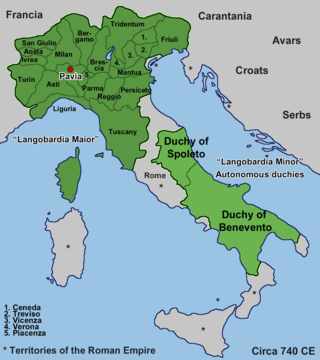
The Carolingian dynasty was a Frankish noble family named after Charles Martel and his grandson Charlemagne, descendants of the Arnulfing and Pippinid clans of the 7th century AD. The dynasty consolidated its power in the 8th century, eventually making the offices of mayor of the palace and dux et princeps Francorum hereditary, and becoming the de facto rulers of the Franks as the real powers behind the Merovingian throne. In 751 the Merovingian dynasty which had ruled the Franks was overthrown with the consent of the Papacy and the aristocracy, and Pepin the Short, son of Martel, was crowned King of the Franks. The Carolingian dynasty reached its peak in 800 with the crowning of Charlemagne as the first Emperor of the Romans in the West in over three centuries. Nearly every monarch of France from Charlemagne's son Louis the Pious till the penultimate monarch of France Louis Philippe have been his descendants. His death in 814 began an extended period of fragmentation of the Carolingian Empire and decline that would eventually lead to the evolution of the Kingdom of France and the Holy Roman Empire.
The history of Bavaria stretches from its earliest settlement and its formation as a stem duchy in the 6th century through its inclusion in the Holy Roman Empire to its status as an independent kingdom and finally as a large Bundesland (state) of the Federal Republic of Germany. Originally settled by Celtic peoples such as the Boii, by the 1st century BC it was eventually conquered and incorporated into the Roman Empire as the provinces of Raetia and Noricum.

Bavarians are an ethnographic group of Germans of the Bavaria region, a state within Germany. The group's dialect or speech is known as the Bavarian language, native to Altbayern, roughly the territory of the Electorate of Bavaria in the 17th century.

Sigebert III was the Merovingian king of Austrasia from 633 to his death around 656. He was described as the first Merovingian roi fainéant —do-nothing king—, in effect the mayor of the palace ruling the kingdom throughout his reign. However he lived a pious Christian life and was later sanctified, being remembered as Saint Sigebert of Austrasia in the Roman Catholic Church and Eastern Orthodox Church.

The Duchy of Benevento was the southernmost Lombard duchy in the Italian Peninsula that was centred on Benevento, a city in Southern Italy. Lombard dukes ruled Benevento from 571 to 1077, when it was conquered by the Normans for four years before it was given to the Pope. Being cut off from the rest of the Lombard possessions by the papal Duchy of Rome, Benevento was practically independent from the start. Only during the reigns of Grimoald and the kings from Liutprand on was the duchy closely tied to the Kingdom of the Lombards. After the fall of the kingdom in 774, the duchy became the sole Lombard territory which continued to exist as a rump state, maintaining its de facto independence for nearly 300 years, although it was divided after 849. Benevento dwindled in size in the early 11th century, and was completely captured by the Norman Robert Guiscard in 1053.

The Duchy of Bavaria was a frontier region in the southeastern part of the Merovingian kingdom from the sixth through the eighth century. It was settled by Bavarian tribes and ruled by dukes (duces) under Frankish overlordship. A new duchy was created from this area during the decline of the Carolingian Empire in the late ninth century. It became one of the stem duchies of the East Frankish realm, which evolved as the Kingdom of Germany and the Holy Roman Empire.

The Agilolfings were a noble family that ruled the Duchy of Bavaria on behalf of their Merovingian suzerains from about 550 until 788. A cadet branch of the Agilolfings also ruled the Kingdom of the Lombards intermittently from 616 to 712. They are mentioned as the leading dynasty in the Lex Baiuvariorum. Their Bavarian residence was at Regensburg.

Otto I was the Duke of Swabia from 973 and Duke of Bavaria from 976. He was a member of the Ottonian dynasty, the only son of Duke Liudolf of Swabia and his wife Ida, and thus a grandson of the Emperor Otto I and his Anglo-Saxon wife Eadgyth. His sister Mathilde was the abbess of Essen Abbey.

Perctarit was the first Catholic king of the Lombards who lead a religiously divided kingdom during the 7th Century. He ruled from 661 to 662 the first time and later from 671 to 688. He is significant for making Catholicism the official religion, sparing the life of an invading leader, and building projects around the capital.

Grimoald or Grimwald (†671) was a 7th-century King of Italy, ruling as Duke of Benevento from 647 to 662, and then as King of the Lombards from 662 until his death in 671.

Arechis II was a Duke of Benevento, in Southern Italy. He sought to expand the Beneventos' influence into areas of Italy that were still under Byzantine control, but he also had to defend against Charlemagne, who had conquered northern Italy.
Arechis I was the second Duke of Benevento from 591 to his death in 641.
Regintrud, also known as Reginlind and Regentrud, was probably the wife of Duke Theodbert of Bavaria or of his father Duke Theodo of Bavaria. A possibly identical Regintrud became abbess of Nonnberg Abbey in 720–725. However, details about her ancestry and life are widely disputed among historians.
Theodbert was the duke of Bavaria in some capacity or other from 702 to his death. He was the eldest son of Duke Theodo of Bavaria and Folchaid. He was first associated with his father as duke in 702, ruling from Salzburg. In 711, his younger brother Theobald was co-ruling as well and his father was making plans for a fourfold division of the duchy on his death. Sometime before 715, the division was given, but whether territorial or coregent is not known. If the former, the dioceses set up by Theodo probably corresponded to the duchies of his sons. In that scenario, Theodbert probably had his seat at Salzburg, as since 702.
Grimoald was the duke of Bavaria from about 715 to his death.
Gisulf II was the Duke of Friuli from around 591 to his death. He was the son and successor of Grasulf I of Friuli.

Theodo, also known as Theodo V and Theodo II, was the Duke of Bavaria from 670 or, more probably, 680 to his death. It is with Theodo that the well-sourced history of Bavaria begins. He strengthened his duchy internally and externally and, according to the medieval chronicler Arbeo of Freising, he was a prince of great power whose fame extended beyond his borders.

The Kingdom of the Lombards, also known as the Lombard Kingdom and later as the Kingdom of all Italy, was an early medieval state established by the Lombards, a Germanic people, on the Italian Peninsula in the latter part of the 6th century. The king was traditionally elected by the very highest-ranking aristocrats, the dukes, as several attempts to establish a hereditary dynasty failed. The kingdom was subdivided into a varying number of duchies, ruled by semi-autonomous dukes, which were in turn subdivided into gastaldates at the municipal level. The capital of the kingdom and the center of its political life was Pavia in the modern northern Italian region of Lombardy.

The Duchy of Friuli was a Lombard duchy in present-day Friuli, the first to be established after the conquest of the Italian peninsula in 568. It was one of the largest domains in Langobardia Major and an important buffer between the Lombard kingdom and the Slavs, Avars, and the Byzantine Empire. The original chief city in the province was Roman Aquileia, but the Lombard capital of Friuli was Forum Julii, modern Cividale.











